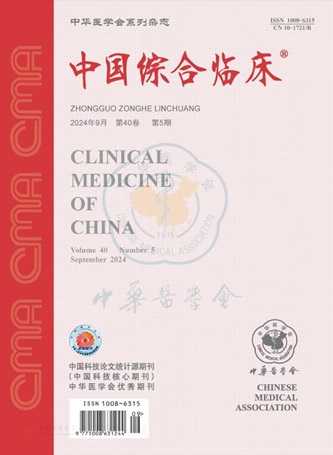Diagnostic Value of Astograph Airway Responsiveness Measurement in Chest Suffocation Variant Asthma
引用次数: 0
Abstract
Objective To investigate the diagnostic value of Astograph methacholine provocation test in patients with chest tightness variant asthma(CTVA). Methods From January 2011 to February 2017, 156 patients with CTVA in outpatient or inpatient department of respiratory medicine of Kailuan General Hospital affiliated to North China University of Science and Technology were selected as case group (chest tightness variant asthma group). The control group were 361 non-asthmatic patients including interstitial lung disease(23 cases), coronary disease (157 cases), hypertensive cardiopathy(22 cases), myocardiosis (16 cases), congenital heart disease (3 cases), rheumatic valvular heart disease (6 cases), central airway disease (3 cases), thyromegaly (10 cases), mediastinal tumor (5 cases), thoracic or spinal deformity (8 cases), phrenoparalysis (2 cases) and vegetative nerve functional disturbance (106 cases). All participants received pulmonay ventilation test, average daily and nightly variation rate of PEF(Peak expiratory flow) or PEF weekly variability, Astograph methacholine provocation test (forced expirataory volume in one second≥70% expectation), and other relevant examinations.The diagnostic value of Astograph methacholine provocation test on CTVA was assessed by analyzing the sensitivity, specificity, positive predictive value, negative predictive value, and Yunden index of Astograph methacholine airway. Results Compared with the control group((1.18±0.44)%), theforced expiratory flow from 75% of Forced vital capcacity (FEF75)index of CTVA group((1.29±0.50)%) had significant difference(, t=2.96, P=0.006). The sensitivity, specificity, positive predictive value, negative predictive value, Yunden index, and diagnostic accuracy of Astograph methacholine provocation test on CTVA were 0.814, 0.695, 0.536, 0.305, 0.509 and 0.731, respectively. Conclusion The sensitivity, negative predictive value, Yunden index and diagnostic accuracy of Astograph methacholine provocation test on CTVA were higher, whereas the specificity and positive predictive value were relatively lower, suggesting that Astograph methacholine provocation test had a reliable diagnostic value on CTVA, with lower false negative and higher false positive. Key words: Astograph method; Chest tightness variant asthma; DiagnosisAstograph气道反应性测定对胸闷变异性哮喘的诊断价值
目的探讨Astograph甲胆碱激发试验对胸闷变异性哮喘(CTVA)的诊断价值。方法选取2011年1月至2017年2月在华北理工大学附属开滦总医院呼吸内科门诊或住院的CTVA患者156例作为病例组(胸闷变异性哮喘组)。对照组为非哮喘患者361例,包括间质性肺疾病23例、冠心病157例、高血压心脏病22例、心肌病16例、先天性心脏病3例、风湿性心瓣膜病6例、中枢性气道疾病3例、胸腺肿大10例、纵隔肿瘤5例、胸椎或脊柱畸形8例、膈神经麻痹2例、植物性神经功能障碍106例。所有受试者均接受肺通气试验、平均每日和夜间PEF(呼气峰值流量)变化率或PEF每周变化率、Astograph甲胆碱激发试验(一秒用力呼气量≥70%预期)等相关检查。通过分析Astograph甲胆碱气道的敏感性、特异性、阳性预测值、阴性预测值和云登指数,评价Astograph甲胆碱激发试验对CTVA的诊断价值。结果与对照组((1.18±0.44)%)比较,CTVA组75%用力肺活量(FEF75)指数((1.29±0.50)%)差异有统计学意义(t=2.96, P=0.006)。Astograph甲胆碱激发试验对CTVA的敏感性、特异性、阳性预测值、阴性预测值、云登指数和诊断准确率分别为0.814、0.695、0.536、0.305、0.509和0.731。结论Astograph甲胆碱激发试验对CTVA的敏感性、阴性预测值、云登指数和诊断准确率较高,特异性和阳性预测值相对较低,提示Astograph甲胆碱激发试验对CTVA具有可靠的诊断价值,假阴性较低,假阳性较高。关键词:星相图法;胸闷变异性哮喘;诊断
本文章由计算机程序翻译,如有差异,请以英文原文为准。
求助全文
约1分钟内获得全文
求助全文
来源期刊
CiteScore
0.10
自引率
0.00%
发文量
16855
期刊介绍:
Clinical Medicine of China is an academic journal organized by the Chinese Medical Association (CMA), which mainly publishes original research papers, reviews and commentaries in the field.
Clinical Medicine of China is a source journal of Peking University (2000 and 2004 editions), a core journal of Chinese science and technology, an academic journal of RCCSE China Core (Extended Edition), and has been published in Chemical Abstracts of the United States (CA), Abstracts Journal of Russia (AJ), Chinese Core Journals (Selection) Database, Chinese Science and Technology Materials Directory, Wanfang Database, China Academic Journal Database, JST Japan Science and Technology Agency Database (Japanese) (2018) and other databases.

 求助内容:
求助内容: 应助结果提醒方式:
应助结果提醒方式:


